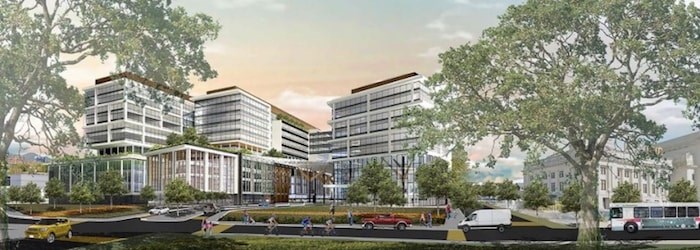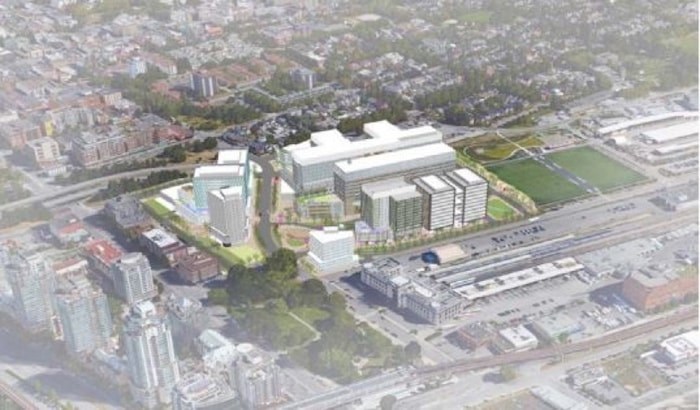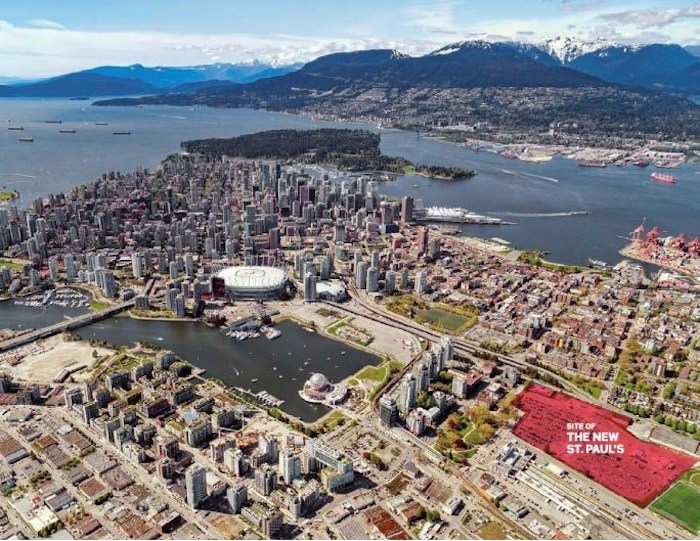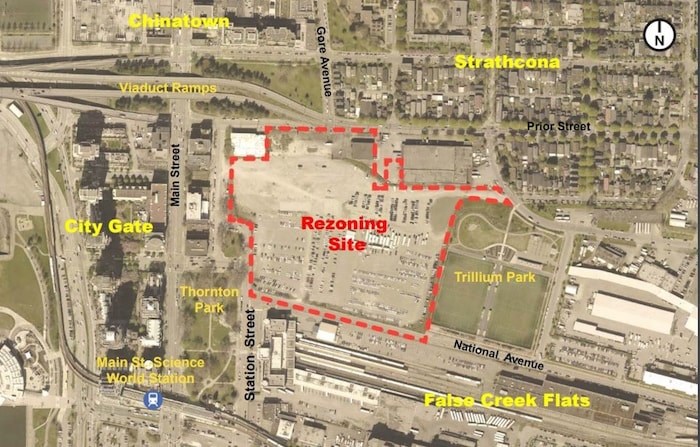 City council approved rezoning for the new St. Paul’s site on Nov. 5.
City council approved rezoning for the new St. Paul’s site on Nov. 5.
Vancouver council approved Providence Health Care Society’s rezoning application to build a new $1.9-billion hospital and health care facility on an 18.4-acre site on False Creek Flats in an 8-3 vote Nov. 5.
Only Green Party councillors Adriane Carr and Pete Fry, as well as NPA Coun. Colleen Hardwick opposed the application.
Plans for the property at 1002 Station St. and 250 to 310 Prior St. are for a new hospital and health care facility to replace the existing century-old St. Paul’s hospital on Burrard Street, as well as institutional, office, research, hotel, retail-service and Indigenous cultural uses, and limited rental housing for health care workers. The plan also features a new public plaza, two childcare facilities and a new road network through the site to connect existing adjacent streets. Building heights will range between 24 and 61 metres.
The site will be developed in several phases over 20 years beginning with the hospital, which has an anticipated completion date of 2026.
The fact the property is on a flood plain and high-risk seismic and liquefaction zone has sparked concerns from some residents and some councillors.
 Rendering of new St. Paul’s hospital project.
Rendering of new St. Paul’s hospital project.
However, conditions were included in the rezoning application that require comprehensive all-hazard risk and vulnerability assessments to be completed, and seismic resilience measures must be incorporated into the design of the building. The conditions also require a five-member expert panel be struck to evaluate the resilience of the design, and on the post-disaster functionality of the hospital, although recommendations won’t be binding.
Prior to the debate and council’s vote, Rhonda Lui, Providence Health Care’s associate director for design build, acknowledged the potential for liquefaction exists at the site, but she said PHC has budgeted to remove the fill and the buildings will be supported on glacial till that exists below the fill, which is not liquefiable.
Lui said all site challenges have been studied related to soil conditions, seismic vulnerability and resilience planning. She added hundreds of bore holes have been drilled to inform engineering solutions. Geotechnical, hydro geotechnical and environmental analyses have also been completed.
The hospital falls within the national building code’s post-disaster category, which means PHC must ensure the hospital will remain operational post disaster.
Lui said while concerns were raised about emergency access, studies have been done on that subject and access routes for different uses have been separated. Some speakers at the public hearing called for an increase in the number of residential units planned for the site, which Lui said PCH is open to, but it would like the footprint for the residential portion of the property to remain as presented.
 Aerial view of site.
Aerial view of site.
Those reassurances satisfied most, but not all, of the councillors, with seven councillors and the mayor ultimately supporting the rezoning application.
NPA Coun. Melissa De Genova said St. Paul’s needs a new home, and the project will make Vancouver a better city. She also pointed out people wouldn’t fare better if St. Paul’s remained at its current location.
NPA Coun. Lisa Dominato agreed St. Paul’s has outgrown its existing home and highlighted the opportunities within the development for research uses, housing and a hotel. She said the project will have a “very positive impact” on the neighbouring community. Dominato also successfully introduced an amendment to the main motion, which will see city staff and PHC explore the possibility of integrating mental health and substance use treatment beds into the new hospital and health care campus.
COPE Coun. Jean Swanson voted in favour of rezoning but she expressed fears that the area is being gentrified and the development will push rents up for SROs.
Swanson introduced an amendment calling for staff to report back on ways to protect lower-rent housing and SROs in the vicinity of the new hospital from gentrification, but Mayor Kennedy Stewart ruled it out of order. He told Swanson she could bring it up as a separate motion at another time.
Councillors Carr and Hardwick, meanwhile, were particularly concerned about seismic and environmental issues.
Hardwick said she recognized St. Paul’s is “eager to have larger and new facilities” but questioned the merits of the new location. After hearing Lui’s explanation about building plans for the hospital, she still raised concerns about the roads and other buildings planned for the site.
“I’ve been watching this property for decades and, as I’ve mentioned before, I’ve seen proposals go through in the mid-’90s that were denied because of concerns about the seismic limitations and vulnerabilities combined with the fact this is infill on glacial till,” she said.
 The site of the new St. Paul’s hospital and health care facility.
The site of the new St. Paul’s hospital and health care facility.
“I’m not satisfied through the discussions we’ve heard that that has been adequately addressed through this process. I see this as putting the city in serious vulnerability.”
Carr said she’s concerned about protecting the site from rising sea levels and cited author Ian McHarg’s textbook Design with Nature to explain her position.
“You don’t put major infrastructure and emergency systems in a vulnerable area like a flood plain... You just don’t do it. Based on that, I can’t, in good conscience, support this even though I think the design is very much in the right direction,” she said.
In a statement after the vote, Fiona Dalton, president and CEO of Providence Health Care, praised the rezoning approval.
"In the years leading up to this decision, hundreds of people shared their ideas for the future of St. Paul's. We listened to the diverse voices of people, stakeholders and communities, including residents of the area, seniors, Indigenous peoples, community groups, business owners, doctors, staff, patients, and more," Dalton said.
"The result is going to be a world-class health care, research and teaching centre that will help transform patient care for British Columbians."
Council’s decision comes four years after PHC announced, in April of 2015, that the aging St. Paul’s Hospital on Burrard Street would be replaced by a new state-of-the-art hospital and health care facility, and two years after council approved a policy statement for the Station Street site.
The existing 6.6-acre St. Paul’s Hospital site on Burrard was listed for sale last spring.
Proceeds will help cover costs for the new facility. The hospital will continue to operate in its current location until the new hospital is finished.



